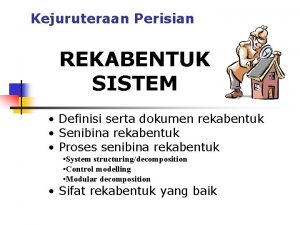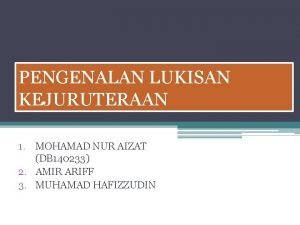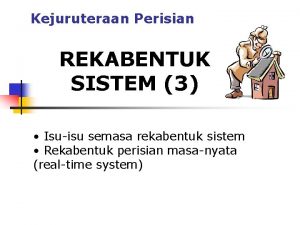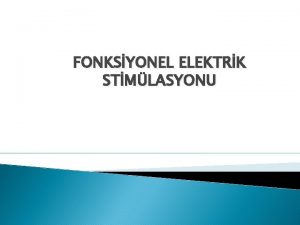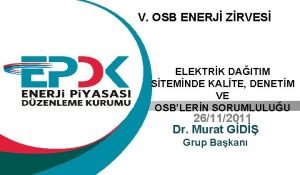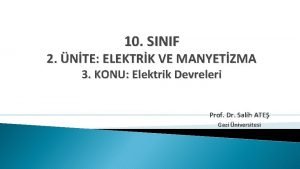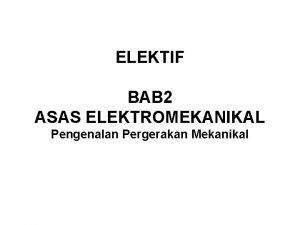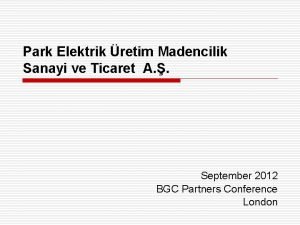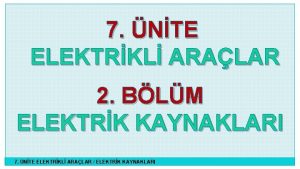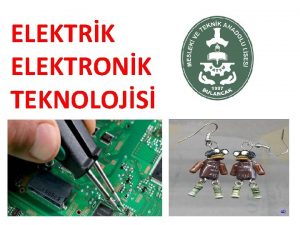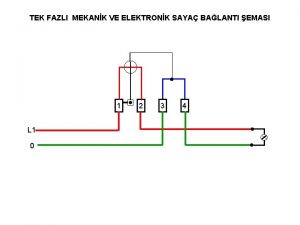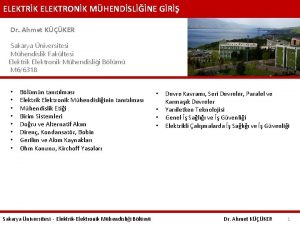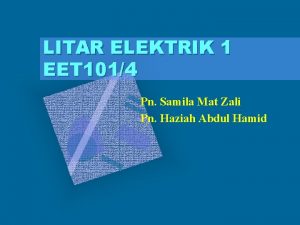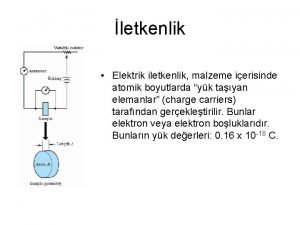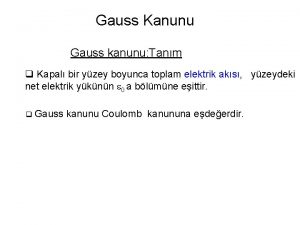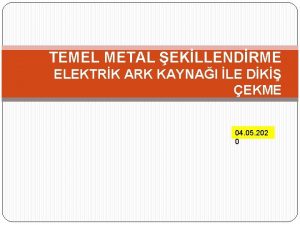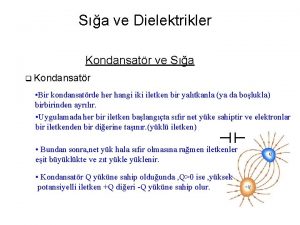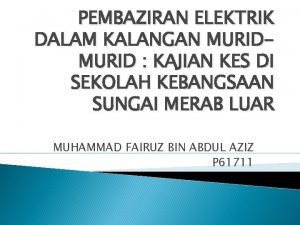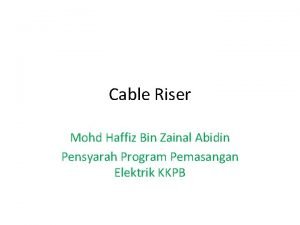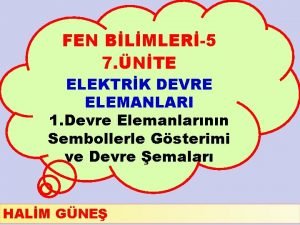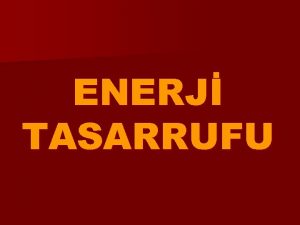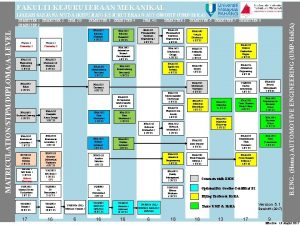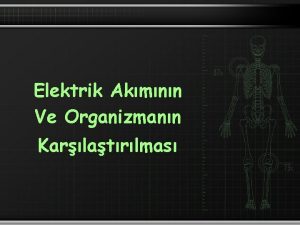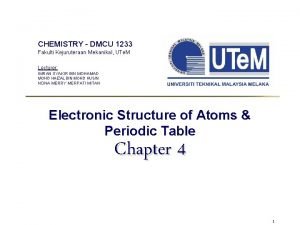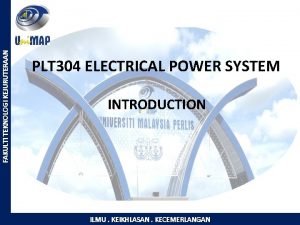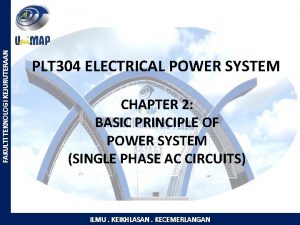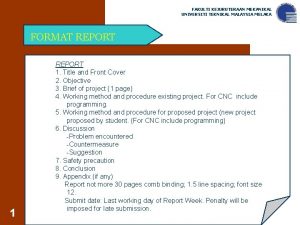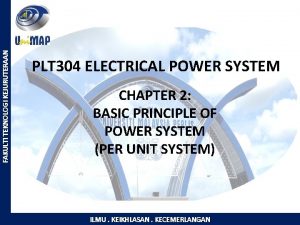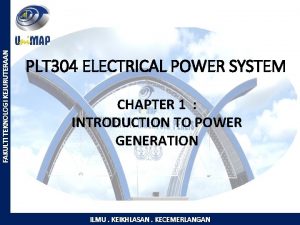Fakulti Kejuruteraan Elektrik Fakulti Kejuruteraan Elektrik Methods of











































- Slides: 43

Fakulti Kejuruteraan Elektrik

Fakulti Kejuruteraan Elektrik Methods of Analysis • • Nodal Analysis Mesh Analysis - with both independent voltage and current sources - With both dependent voltage and current sources

NODAL ANALYSIS 3

Nodal Analysis It provides a general procedure for analyzing circuits using node voltages as the circuit variables. Example 1 4

Nodal Analysis Steps to determine the node voltages: 1. Select a node as the reference node. 2. Assign voltages v 1, v 2, …, vn-1 to the remaining n-1 nodes. The voltages are referenced with respect to the reference node. 3. Apply KCL to each of the n-1 non-reference nodes. Use Ohm’s law to express the branch currents in terms of node voltages. 4. Solve the resulting simultaneous equations to obtain the unknown node voltages. 5

Reference node: zero potential 6

1 + v 1 - Circuit with current sources only 2 + v 2 0 v 1 i 2 i 1 v 2 i 3

v 1 i 2 i 1 Ohm’s law: v 2 i 3 i 1, i 2 and i 3 : in terms of node voltages Applying KCL At node 1: At node 2 8

v 1 i 2 i 1 v 2 i 3 9

In terms of the conductances: In matrix form: Solve for the node voltages -cramer’s rule -Substitution method -elimination method -Calculators -Software packages 10

11

Practice problem 3. 1 (pg 85) 3 12

13

Practice Problem 3. 2 (page 88) 14

Nodal analysis with voltage sources Case 1: If a voltage source is connected between the reference node and the non-reference node, we simply set the voltage at the non-reference equal to the voltage of the voltage source. Case 2: When a voltage source (dependent or independent) is connected between two nonreference nodes, we can combine those nodes to form a supernode: KCL and KVL will be applied to determine the node voltages 15

Node 2 and 3 form a supernode 1 st – Applying KCL to the supernode; (Supernode eqns) 2 nd – Applying KVL to get the relationship between the two nodes. (Supporting eqns) 16

At the supernode: KCL at supernode KVL to the supernode 17

18

Practice Problem 3. 3 (page 90) 19

20

Practice problem 3. 4 (page 93) 21

MESH ANALYSIS 22

Mesh Analysis Only applicable to a planar circuit only Planar Circuit: the circuit that can be drawn in a plane with no branches crossing one another, otherwise it is nonplanar. 23

Planar circuit 24

Planar circuit 25

Nonplanar circuit 26

Nonplanar 27

Mesh Analysis 1. Mesh analysis provides another general procedure for analyzing circuits using mesh currents as the circuit variables. 2. Nodal analysis applies KCL to find unknown voltages in a given circuit, while mesh analysis applies KVL to find unknown currents. 3. A mesh is a loop which does not contain any other loops within it. 28

Mesh Analysis Steps to determine the mesh currents: 1. Assign mesh currents i 1, i 2, …, in to the meshes. n 2. Apply KCL to each of the n meshes. Use Ohm’s law to express the voltages in terms of the mesh currents. 3. Solve the resulting n simultaneous equations to get the mesh currents. 29

i 1 Applying KVL to mesh 1 i 2 Applying KVL to mesh 2 30

Example 3. 5 31

Practice problem 3. 5 (page 96) 32

Example 3. 6 33

Practice Problem 3. 6 (page 98) 34

Mesh analysis with Current sources Case 1: When a current source exists only in one mesh, we simply take the value for that loop/mesh equal to the value stated for the current source 35

Mesh analysis with Current sources Case 2: If the current source (dependent or independent) exists between two meshes, we create a supermesh by excluding the current source and any elements connected in series with it. 36

Mesh 1 and 2 form a supermesh 1 st – Applying KVL to the supermesh; (Supermesh eqns) 2 nd – Applying KCL to a node in the branch where the two meshes intersect. (Supporting eqns) 37

38

Practice problem 3. 7 a) Determine i 1, i 2 and i 3 b) Determine the current through each element. 39

Problem 3. 38 a) Appy mesh analysis to obtain Io 40

Problem 3. 27 Use nodal analysis to find voltages V 1, V 2 and V 3 41

Problem 3. 31 Find the node voltages for the circuit below 42

Problem 3. 64 Find vo and io 43
 Fakulti pengajian pendidikan
Fakulti pengajian pendidikan Paradigma kejuruteraan perisian
Paradigma kejuruteraan perisian Kejuruteraan pembuatan
Kejuruteraan pembuatan Dokumen paradigma kejuruteraan perisian
Dokumen paradigma kejuruteraan perisian Poligon dalam bulatan
Poligon dalam bulatan Sesiku segitiga
Sesiku segitiga Kejuruteraan perisian
Kejuruteraan perisian Wax pattern in fpd
Wax pattern in fpd Anakart üzerinde elektrik akımı olmadığı durumlarda
Anakart üzerinde elektrik akımı olmadığı durumlarda Fes akımı
Fes akımı Ege bölgesi elektrik dağıtım şirketleri
Ege bölgesi elektrik dağıtım şirketleri Elektrik akımının oluşturabileceği tehlikeler
Elektrik akımının oluşturabileceği tehlikeler Jenis pergerakan mekanikal
Jenis pergerakan mekanikal Park elektrik
Park elektrik Elektrik birim
Elektrik birim Kesirler
Kesirler Elektriksel potansiyel enerji
Elektriksel potansiyel enerji Elektrik alan
Elektrik alan Cep telefonu tablet gibi araçların elektrik kaynağı
Cep telefonu tablet gibi araçların elektrik kaynağı Elektrik alan k sabiti
Elektrik alan k sabiti Elektrik tesisatları ve dağıtımı dalı
Elektrik tesisatları ve dağıtımı dalı Kombi sayaç bağlantı şeması
Kombi sayaç bağlantı şeması Sistem kerja
Sistem kerja Etika penggunaan teknologi maklumat
Etika penggunaan teknologi maklumat Statik elektrik
Statik elektrik Devre yapım kiti sanal laboratuvar
Devre yapım kiti sanal laboratuvar Litar elektrik ringkas
Litar elektrik ringkas Elektrik cərəyanı haqqında məruzə
Elektrik cərəyanı haqqında məruzə Elmas grafit fulleren
Elmas grafit fulleren Elektrik alan
Elektrik alan Alanlar kanunu
Alanlar kanunu Lem elektrik
Lem elektrik Ark boyu nedir
Ark boyu nedir Rakortman nedir elektrik
Rakortman nedir elektrik Akü elektrik mühendisliği
Akü elektrik mühendisliği Dielektrikler
Dielektrikler Sumber elektrik
Sumber elektrik Faktor pembaziran elektrik
Faktor pembaziran elektrik Sistem pendawaian sesalur
Sistem pendawaian sesalur Harran elektrik elektronik
Harran elektrik elektronik Basit elektrik devresi çizimi
Basit elektrik devresi çizimi Elektrik su ve besin tasarrufu hakkında afiş
Elektrik su ve besin tasarrufu hakkında afiş Jenis penyelenggaraan
Jenis penyelenggaraan Jeotermal elektrik üretimi
Jeotermal elektrik üretimi

